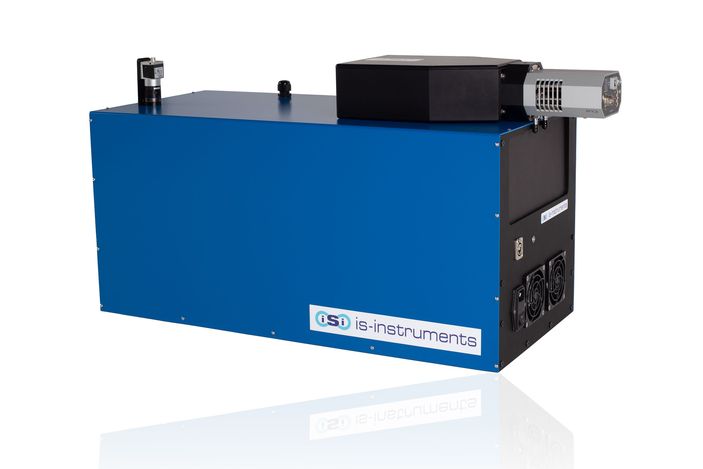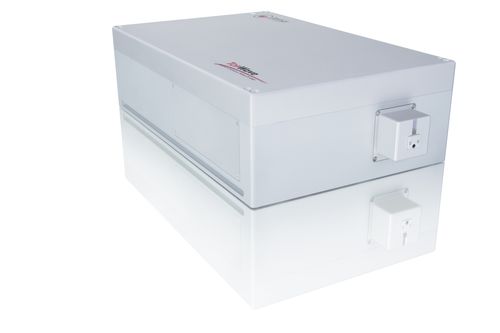Measuring Immunoglobulin without Sample Degradation
ODIN is a new, compact, and reliable deep UV resonant Raman instrument developed by IS-Instruments (ISI) and TOPTICA for measurement of biopharma products. TOPTICA's Industrial CW Laser TopWave 229 enables new Deep UV Raman Spectrometer ODIN.
The system combines the newly developed solid state diode laser TopWave 229 and a spatial heterodyne spectrometer integrated into a single instrument with a unique all-reflective backscatter Raman collection probe. Sample damage caused by extended laser exposure has been mitigated via the introduction of a dynamic sample positioning stage.
New deep-UV laser system, operating at 228.5 nm
The TopWave 229 is an exciting new choice for deep UV spectroscopists looking for a reliable laser that enables the user to focus on their application rather than worrying about the light source. With its short wavelength and an ultra-narrow laser linewidth (< 1 MHz ≙ < 4 x 10-5 cm-1), the TopWave 229 offers the critical features to meet a challenge such as excitation source in the field of deep UV Raman and deep UV fluorescence spectroscopy.
The TopWave 229 was designed for a compact footprint and easy integration. Comfortable, hands-off operation is ensured by fully automated optimization routines for the internal opto-mechanics. In order to provide best reliability and consistent, diffraction limited beam quality (M² ≤ 1.3) the complete UV beam path is enclosed in a specially sealed compartment.
With its state-of-the-art laser controller, the TopWave 229 offers a wide range of operating options and systems integrators will appreciate the comprehensive command language that enables smooth integration with central control software.
Breakthrough in Deep UV Resonant Raman Instrumentation: Measuring Immunoglobulin without Sample Degradation
There are two main reasons for operating at ultraviolet wavelengths:
- Fluorescence mitigation - at UV wavelengths, fluorescence and Raman signatures become spectrally separated
- Many biological samples resonate resulting in their Raman signatures being substantially amplified in comparison to the results obtained when using visible excitation wavelengths
Existing systems use either high powered gas pumped lasers or pseudo-pulsed lasers with low net powers. These are expensive to buy and expensive to maintain, requiring either water-cooling or gas purging. This has limited their application to dedicated research facilities.
ODIN changes all that: a compact, ancillary-free instrument capable of unprecedented Raman characterisation of complex biological materials.
A general description of the instrument is provided by Michael Foster, William Brooks (both IS-I) and Philipp Jahn (TOPTICA) in this white paper: Download White Paper
The technical report describes a new deep UV Raman instrument developed by IS-Instruments (ISI) and TOPTICA, and its first application to the measurement of biopharma products. The instrument performance is excellent acquiring spectra in a fraction of the time compared to existing systems, while its stability, compactness and ease of use are a game changer in terms of deep UV systems. In this note, a general description of the instrument is provided together with a test campaign examining products including IgG and antibody fragments.
The instrument has been demonstrated to successfully capture the Raman spectra of a range of biochemical samples, including immunoglobulin (IgG) at varying concentrations, tryptophan, and a series of domain antibody (dAb) samples. The dAb samples were extracted at different stages of a pilot bioreactor manufacturing process and at varying dilutions. To the knowledge of the authors, this is the first time an observation of this type has been made.
Image: Raman spectra of IgG (30 second integration time, average of 10 frames). Solid black line = |gG is measured in static configuration; Dotted black line IgG measured with sample rotating during the observation; Red line=|gG measured with a complex motion applied using a rotation and linear stage
“Deep UV resonant Raman has long been known to have the potential for being able to measure substances other spectroscopic techniques have not so far been capable of. Equally, the instruments currently available are extremely large, and expensive both to purchase and to maintain. This has made the technology accessible only to those organisations with physical space to house them and with significant budgets to operate them. Odin represents a departure from that as itis smaller and doesn't have the internal mechanisms associated with high running costs.” - Dr Michael Foster, Co-Founder & Director, IS-Instruments
About IS-Instruments
ISI is a UK R&D company that designs and develops remote sensing instrumentation for use in hostile and high-temperature environments. Clients include National Grid, Xstrata, European Space Agency and ABSL Space Products. ISI was co-founded in 2010 by Directors Dr Michael Foster and Dr Jonathan Storey, with Nicholas Bantin. The Directors are renowned worldwide as experts in Optical filtering systems, Laser-enhanced remote sensing instrumentation, Photon Counting Techniques and High-precision interferometry.
Go to www.toptica.com for the Laser source TopWave 229
Go to www.is-instruments.com for the UV Raman Spectrometer ODIN



